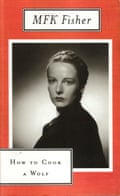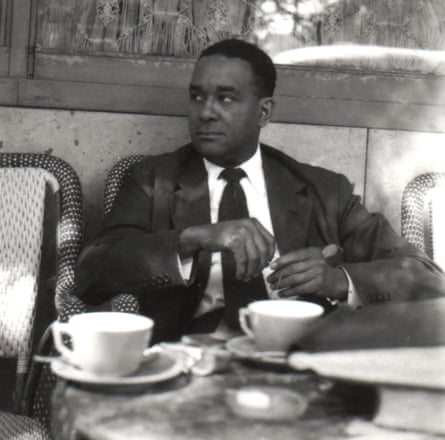The 100 best nonfiction books: No 37 – How to Cook a Wolf by MFK Fisher (1942)
Monday 10 October 2016
To WH Auden, in 1963, she was America’s “greatest writer”. The poet declared, “I do not know of anyone in the United States who writes better prose”, a verdict that mixed provocation and tease in a way that would have delighted Mary Frances Kennedy Fisher.
 |
| Mary Frances Kennedy Fisher at home in Sonoma, California in 1971: ‘If you have to eat to live, you may as well enjoy it.’ Photograph: Richard Drew |
The author of more than 25 inimitable books on food (each a highly original macedoine of cooking, travel, and autobiography) MFK Fisher was nothing if not singular, and had been so since childhood, growing up in California, the daughter of Rex Kennedy, the editor-proprietor of a string of small-town newspapers.
Food and writing became her obsession early on. While her father commissioned her to write for him, her mother indulged the young Mary “in a voluptuous riot of things like marshmallows in hot chocolate, thin pastry under the Tuesday hash, rare roast beef on Sunday instead of boiled hen”. Not to be outdone, her father would serve “a local wine, red-ink he called it, with the steak; we ate grilled sweetbreads and skewered kidneys with a daring dash of sherry.”
At the age of 21, Mary married her college sweetheart, Al Fisher, and, like many young Americans between the wars, moved to France, a life she would mythologise in retrospect: “We ate terrines of pate 10 years old under their tight crusts of mildewed fat. We tied napkins under our chins and splashed in great odorous bowls of écrevisses à la nage. We addled our palates with snipes hung so long they fell from their hooks, to be roasted then on cushions of toast softened with the paste of their rotted innards.”

Her marriage failed; she had affairs, and was photographed by Man Ray, but always recognised her limits. “I wasn’t so pretty that I didn’t have to do something else,” she said. As a single woman, she “spent hours in my kitchen cooking for people, trying to blast their safe, tidy little lives with a tureen of hot borscht and some garlic-toast and salad, instead of the fruit cocktail, fish, meat, vegetable, salad, dessert and coffee they tuck daintily away seven times a week.” Now she discovered her vocation, which quickly became a passion indistinguishable from the others in her life.
“People ask me,” Fisher once wrote, “why do you write about food, and eating and drinking? Why don’t you write about the struggle for power and security and about love?” This question, she noted, would be levelled like an accusation, “as if I were unfaithful to the honour of my craft”. Her reply was that to say she was hungry, like most other humans, was not enough. “It seems to me that our three basic needs, for food and security and love, are so mixed and mingled and entwined that we cannot straightly think of one without the others. So it happens that when I write of hunger, I am really writing about love and the hunger for it, and warmth and the love of it and the hunger for it.” Never less than deeply sensual, Fisher added, “the warmth and richness and fine reality of hunger satisfied… and it is all one.”
Fisher’s prose was remarkable in quality and quantity. She wrote hundreds of stories for the New Yorker, as well as 15 books of essays and memoir. She produced the best English translation of Brillat-Savarin’s 1825 classic The Physiology of Taste, as well as a novel, a screenplay, a book for children and many travelogues. Other food writers would confine their writing to the recipes or the mundane details of a particular cuisine, but MFK Fisher used food as a metaphor. Inevitably, as she complained in a 1990 interview, her subject matter “caused serious writers and critics to dismiss me for many, many years. It was woman’s stuff, a trifle.” But she remained true to her self, described, in her 1943 volume, as The Gastronomical Me. Her critics eventually caught up. “In a properly run culture,” wrote the New York Times Book Review, “Mary Frances Kennedy Fisher would be recognised as one of the great writers this country has produced in this century.”
Her first book, Serve It Forth (1937), made this declaration: “if you have to eat to live, you may as well enjoy it.” This theme was repeated in Consider the Oyster (1941): “An oyster leads a dreadful but exciting life. Indeed, his chance to live at all is slim, and if he should survive the arrows of his own outrageous fortune and in the two weeks of his carefree youth find a clean smooth place to fix on, the years afterwards are full of stress, passion and danger…”
Fisher’s embrace of the slow, sensual pleasures of the table was matched by her cool acceptance of sudden jeopardy and violence. One critic of How to Cook a Wolf noted “the faintly Gothic perversity that makes Mrs Fisher’s literature unique”. For Fisher, How to Cook a Wolf was “about living as decently as possible with the ration cards and blackouts of World War II”. It was also a poignant farewell to the author’s youthful exuberance:
“There are very few men and women, I suspect, who cooked and marketed their way though the past war without losing for ever some of the nonchalant extravagance of the 1920s. They will feel, until their final days on earth, a kind of culinary caution: butter, no matter how unlimited, is a precious substance; meats, too, and eggs, and all the far brought spices of the world, take on a new significance, having once been so rare.”
It’s in such passages that you can detect the strong affinities between Fisher and her British counterpart, Elizabeth David (No 30 in this series). Even when the wolf was at the door, she was always a fierce advocate of a libertarian approach to cooking and eating. “Now, of all times in our history,” she declares, “we should be using our minds to live gracefully if we live at all.” Fisher hated the tyranny of the American diet:
“In our furious efforts to prove that all men are created equal we encourage our radios, our movies, above all our weekly and monthly magazines, to set up a fantastic ideal in the minds of family cooks, so that everywhere earnest eager women are whipping themselves and their budgets to the bone to provide three ‘balanced’ meals a day for their men and children.”
As well as polemical, How to Cook a Wolf is also subversive. The chapter “How to Catch the Wolf” is a witty assault on the tyranny of “thrift”. And “How to Distribute Your Virtue” is, frankly, plain saucy. To avoid accusations of self-indulgence, Fisher also has chapters such as “How to Boil Water”, “How Not to Boil an Egg” and “How to be Cheerful Through Starving”. Her trademark sensuality is never far away: “How to Be Content With a Vegetable Love”; “How to Have a Sleek Pelt” and “How to Drink to the Wolf”.
The reviews of How to Cook a Wolf described it as “irresistibly seductive”, “a book you can hardly wait to get your teeth into” and “a licence to dream”. It’s hard not to imagine that her critics were really describing MFK Fisher herself who, on the final page of How to Cook a Wolf, celebrated “the pleasures of the flesh”.
Fisher’s credo was to live a full life. She had no time for prudence, especially at the table. In An Alphabet for Gourmets (1949) she wrote: “A complete lack of caution is perhaps one of the true signs of a real gourmet: he has no need for it, being filled as he is with a God-given and intelligently self-cultivated sense of gastronomical freedom. He not only knows from everything admirable he has read that he will not like Irish whiskey with pineapple chilled in honey and vermouth, or a vintage Chambertin with poached lake perch; but every taste bud on both his actual and his spiritual palate wilts in revulsion at such thoughts. He does not serve these combinations, not because he has been told, but because he knows.”
A signature sentence
“For several years before France fell, Paris newspapers as different as Le Temps and L’Intransigeant ran irate and direful letters from old-fashioned chefs predicting that sure as shooting something awful would happen to the whole country unless the young people forgot their new fad for sports and grilled-steak-with-watercress and went back intelligently to the rich cuisine des sauces of their fathers.”
Three to compare
Julia Child: Mastering the Art of French Cooking (1961)
Marcella Hazan: The Classic Italian Cookbook (1973)
Anthony Bourdain: Kitchen Confidential: Adventures in the Culinary Underbelly (2000)
002 The Year of Magical Thinking by Joan Didion(2005)
009 Dispatches by Michael Herr (1977)
010 The Selfish Gene by Richard Dawkins
021 The Structure of Scientific Revolutions by Thomas S Kuhn (1962)
022 A Grief Observed by CS Lewis (1961)







